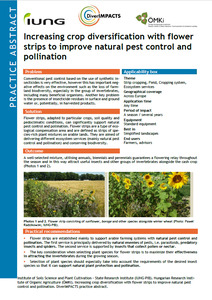{Tool} Increasing crop diversification with flower strips to improve natural pest control and pollination (DiverIMPACTS Practice Abstract). [Dywersyfikacja upraw poprzez pasy kwietne, w celu poprawy naturalnej kontroli szkodników i efektywności zapylania (DiverIMPACTS Practice Abstract).] Creator(s): Stalenga, Jarosław; Radzikowski, Pawel and Trugly, Bence. Issuing Organisation(s): IUGN - Institute of Soil Science and Plant Cultivation, ÖMKi - Hungarian Research Institute of Organic Agriculture. (2021)
|
PDF
- Published Version
- English
346kB | |
![[thumbnail of 2022-07-20 10_38_38-Posteingang - madelaine.rueger@fibl.org - Outlook.png]](/44300/2.hassmallThumbnailVersion/2022-07-20%2010_38_38-Posteingang%20-%20madelaine.rueger%40fibl.org%20-%20Outlook.png)  Preview |
Image (PNG)
- Cover Image
- English
302kB |
|
PDF
- Published Version
- Polish/Polski
364kB |
Document available online at: https://zenodo.org/record/5724483
Summary in the original language of the document
A well-selected mixture, utilising annuals, biennials and perennials guarantees a flowering relay throughout the season and in this way attract useful insects and other groups of invertebrates alongside the cash crop. This Practice Abstract provides specific practicam recommendations on how to incorporate flower strips. For example, flower strips are established mainly to support arable farming systems with natural pest control and pollination. The first service is principally delivered by natural enemies of pests, i.e. parasitoids, predatory insects and spiders. The second service is supported by insects that collect pollen or nectar. The key consideration when selecting plant species for flower strips is to maximize their effectiveness in attracting the invertebrates during the growing season. Further, selection of plant species should especially take into account the requirements of the desired insect species so that it can support natural plant protection and pollination. Find out more in the Practice Abstract.
Summary translation
Dobrze dobrana mieszanka roślin jednorocznych, dwuletnich i wieloletnich gwarantuje sztafetę kwitnienia przez cały sezon i w ten sposób oprócz plonów przyciąga pożyteczne owady i inne grupy bezkręgowców. Ten praktyczny raport zawiera konkretne zalecenia dotyczące integracji pasów kwitnienia. Dlatego też pasy kwitnienia zakładane są głównie w celu wsparcia systemów uprawnych naturalną ochroną przed szkodnikami i zapylaniem. Pierwszą usługę świadczą głównie naturalni wrogowie szkodników, czyli parazytoidy, owady drapieżne i pająki. Druga usługa świadczona jest przez owady zbierające pyłek lub nektar. Najważniejszą przesłanką przy wyborze gatunków roślin na pasy kwiatowe jest maksymalizacja ich skuteczności w przyciąganiu bezkręgowców w sezonie wegetacyjnym. Ponadto dobór gatunków roślin powinien uwzględniać w szczególności wymagania pożądanych gatunków owadów, tak aby mogły one wspierać naturalną ochronę roślin i zapylanie. Więcej informacji można znaleźć w podsumowaniu praktyki.
| EPrint Type: | Practice tool |
|---|---|
| Teaser: | Learn how flower stript can be used to deliver different ecosystem services and conserving biodiversity. |
| What problem does the tool address?: | Conventional pest control based on the use of synthetic insecticides is very effective, however, this has important negative effects on the environment such as the loss of farmland biodiversity, especially in the group of invertebrates, including many beneficial organisms. Another key problem is the presence of insecticide residues in surface and groundwater or, potentially, in harvested products. |
| What solution does the tool offer?: | Flower strips, adapted to particular crops, soil quality and pedoclimatic conditions, can significantly support natural pest control and pollination. Flower strips are a type of ecological compensation area and are defined as strips of species-rich plant mixtures on arable lands. They are aimed of delivering different ecosystem services (mainly natural pest control and pollination) and conserving biodiversity. |
| Country: | Poland |
| Type of Practice Tool: | Practice abstracts |
| Keywords: | biodiversity, natural enemies, biodiversity conservation, biological control, flower strips |
| Agrovoc keywords: | Language Value URI English biodiversity http://aims.fao.org/aos/agrovoc/c_33949 English natural enemies http://aims.fao.org/aos/agrovoc/c_5085 English biodiversity conservation http://aims.fao.org/aos/agrovoc/c_33955 English biological control http://aims.fao.org/aos/agrovoc/c_918 |
| Subjects: | Environmental aspects > Biodiversity and ecosystem services Crop husbandry > Crop health, quality, protection |
| Research affiliation: | European Union > Horizon 2020 > Diverimpacts Hungary > Hungarian Research Institute of Organic Agriculture Poland European Union > Organic Farm Knowledge |
| Horizon Europe or H2020 Grant Agreement Number: | 727482 |
| Related Links: | https://organic-farmknowledge.org/tool/44300, https://organic-farmknowledge.org/tool/38705, https://twitter.com/farm_knowledge/status/1592072268783538176, https://www.facebook.com/organicfarmknowledge/posts/pfbid028L6Q8KpofSbPHGfWrycv2GGr9MB6unwLzRXurkfjfD3ezBGCpFdKGsyC9yX5ybsMl |
| Project ID: | ofk |
| Deposited By: | Rüger, Madelaine Lea |
| ID Code: | 44300 |
| Deposited On: | 25 Jul 2022 13:31 |
| Last Modified: | 02 May 2024 10:32 |
| Document Language: | English, Polish/Polski |
| Status: | Published |
Repository Staff Only: item control page


